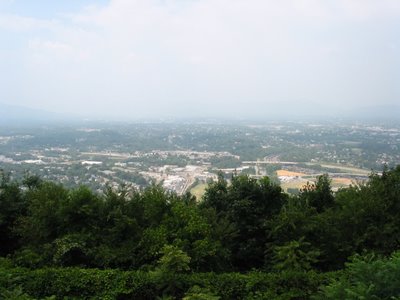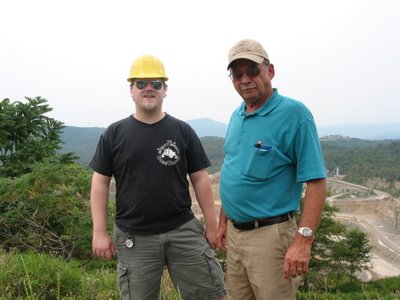Tuesday, August 15, 2006
New Blog!
Saturday, August 12, 2006
Roanoke - Star City of the South

Roanoke's history began in the 1740s when Mark Evans and Tasker Tosh came from Pennsylvania and took up land close to the salt licks where the Indian and animal trails crossed in the center of the valley. The first village in the Roanoke Valley was called Gainsborough (1834), and soon after became known as Big Lick. Roanoke County was formed out of Botetourt County in 1838 and had a population of around 5,000. In 1852, the railroad came into the valley, but missed Big Lick. So, the town moved itself close to the tracks and took the name with it. The previous town of Big Lick became Old Lick, and, in 1874, the new center was chartered as the town of Big Lick. Seven years later, the Shenandoah Valley Railroad came into the town and Big Lick was then renamed Roanoke. The name came from the Indian word "Rawrenock", which was a name for the shell beads that were worn by the Indians and were traded regularly.
By 1882, Roanoke had become a crossroad for the railroad, which soon changed its name to Norfolk and Western Railway. Because of its rapid growth, it was chartered as the City of Roanoke in 1884. Roanoke is still a center for transportation, distribution, trade, manufacturing, health care, entertainment, recreation, attractions, and conventions, and has been awarded the title of "All-American City" on three occasions. Roanoke's population (which includes most of the surrounding cities and towns) has grown to 283,218.
Roanoke has also been named the "Festival City" because of the many festivals held here throughout the year. Some of these are Festival in the Park (which is offers a little bit of everything from concerts to sporting competitions that take place all over the city), Downtown Roanoke's Railway Festival, Henry Street Festival, Vinton's Dogwood Festival (state flower, you know), The Virginia Championship Chili Cook-off (which, sadly, I missed this year and will miss next year as well...Chase has been looking forward to this one for a long time), and the Strawberry Festival (which happens around the same time as the Chili Cook-off so you can normally get some chili and strawberry shortcake all within a short walk of each other).
My favorite part of the city is it's most visible attraction...the Mill Mountain Star. It's a 88.5-foot-high illuminated steel and concrete star that was placed high atop Mill Mountain in 1949, and is considered the World's Largest Man-made standing illuminated Star (even though those blasted Texans tried to outdo us). It uses 2000 feet of neon tubes and 17,500 watts of power. It stands there as a "symbol of the friendliness, industrial and civic progress of Roanoke". Press releases began to identify Roanoke as the "Star City of the South" because on some night you can see the star's glow for a 60-mile radius. I have come to love this star over the years (as my parents and Chase can tell you) and my signal after many long drives to Roanoke in my 14 years of being away, that I am finally home (that is, if I got in before midnight because that is when Roanoke "goes to bed" and turns off the star). Again, blogger is being picky about which pictures it wants to upload, so please check out pictures of the Star at http://en.wikipedia.org/wiki/Mill_Mountain_Star .
By far, the best thing in Roanoke, though, are my parents. :-) I will miss them VERY much while I am galavanting through Europe, but will try as hard as I can to return to see them at Christmas time.
Thursday, August 10, 2006
Where do rocks come from?




This is a question many of us have pondered. Or, few of us...well, just Chase. Thank goodness my stepdad works at a rock quarry! He gave us the nickel tour, and we got to wear hard hats (which I look fabulous in, I must say...lol)! You can always know that anywhere you have to wear a hard hat there's going to be a good time.
We got to see where they were drilling holes for the day's 'shot'. They drop dynamite down the holes, and blow up a large section in order to excavate the stone that is freed. Large bulldozers pick up the stones and drop them into giant two-story trucks called 'eucs' which can carry up to 60-tons each. The eucs take these large stones to the 'jaw' which crushes them.
All of the crushed rock falls from the jaw onto a long conveyor which carries it out of the quarry. It falls onto a large pile. There the larges sizes of rocks are collected, and the smaller bits fall through to another conveyor. This conveyor carries the smaller rocks to another pile, where they collect and smaller pieces fall through to another conveyor and so on and so on. It goes through this NINE TIMES. Did you know there are nine sizes of rocks? Well, there are. And the most expensive rocks are the smallest. Neato! In addition to that they also use these mineral aggregates to manufacture lime, topsoil, and other various and sundry products you never imagined could be made out of crushed rocks.
Guys in big dumptrucks drive up to a pile of rocks, such as 4's, or 7's, and they fill'er up. Then they go to the scale house, where they get weighed. That's where my dad works. He weighs trucks all day long. Then those dumptrucks carry the crushed rock to places like, umm, railroads, and driveways, and umm, well I'm sure there are lots of other places that need crushed rock because that places stays busy.
After the tour we got to go to the very top rim of the quarry and watch the shot! There was a loud siren, then we saw a lot of smoke and dust and a rockslide, then we heard a kaboom! A loud, earth-shattering kaboom! We caught a picture of it, which is actually the first picture that you see.
All in all, the quarry was quite fascinating. Chase would probably like to go get a degree in geology so that he could work with my dad, but that would take another 4 years, and we've got other stuff to do.